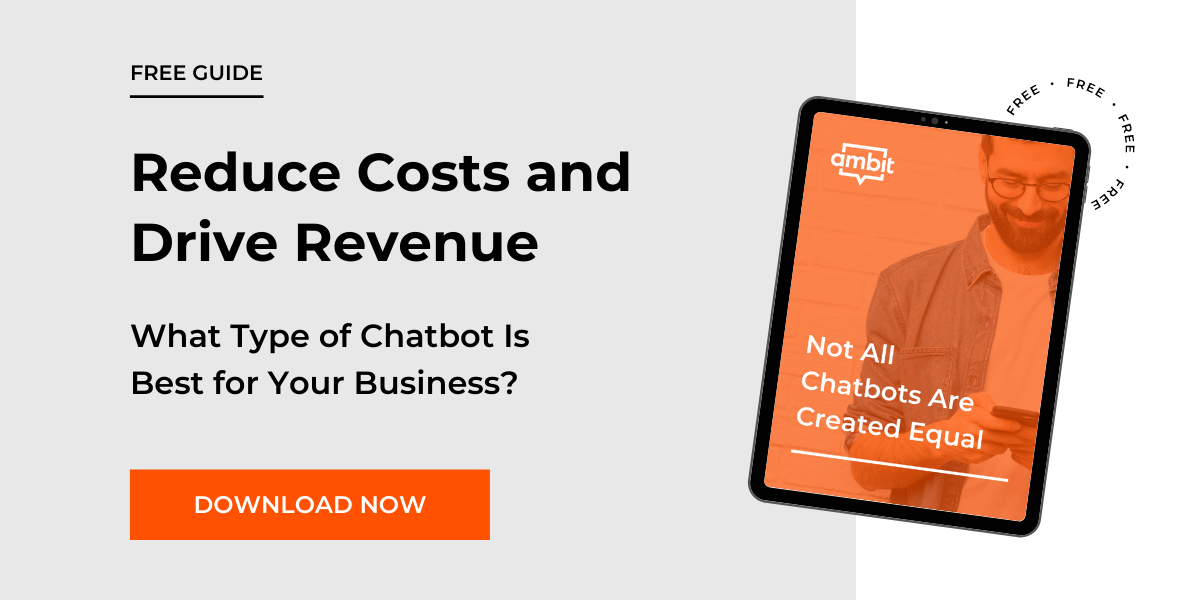Chatbots, or Digital Employee's as they’re also called, is capable of having thousands of simultaneous conversations with a variety of different users.
That’s a lot of information gathered about your customers’ needs and wants.
In a world that’s ruled by data, that information is a golden opportunity to improve the way you interact and engage with both potential and existing customers.
Simple chatbots are great at automating basic inbound enquiries and reduce the load on stretched customer service teams. However, most lack the ability to capture, store, and analyse all that information and data. That means you’re missing out on valuable insights that lead to massive cost reductions and efficiency gains.
Here’s the thing: A Digital Employee is far more capable than just serving up answers to FAQs to give your customer service reps a break. You need to find the right one.
→ Download Now: Find The Right Type of Chatbot
For Your Business [Free Guide]
Like a graduate or new employee, they need to be well trained. Digital Employees go beyond the basic conversation exchange, and not only capture that all-important data, they present it back in meaningful ways to help you improve your business.
Contents
1: Are you really listening? - Unlocking the true voice of your customers
2: Beyond the basics - Evolve your chatbot from a novice to a master
3: Results speak for themselves - Tracking performance and ROI
Are you really listening?
You’ve heard it all before: “To understand what your customers want, try and put yourself in their shoes”. Instead of guessing, stop and listen to what your customers are actually telling you.
That doesn’t mean sending survey after survey, holding focus groups or meeting with every single customer. When you have a Digital Employee on your team, they automatically do the listening for you. And not only do they listen, they capture all that information and turn it into actionable insights.
Capturing these genuine and honest interactions in real-time (and believe me, people are very comfortable expressing themselves to a chatbot!) and classifying them based on theme and sentiment, uncovers the topics your customers care about and what’s important to them.
Not only this, say you on-board a Digital Employee whose focus is on one specific area of the business. You notice there are plenty of customers engaging with the Digital Employee - great! However, when you dig a little deeper, people actually want help with other areas of your business - ones that your Digital Employee is currently unable to help with.
Digging into these analytics helps you broaden the scope of your Digital Employee. This provides a greater level of customer service and limits the number of basic requests flooding your contact centre or service desk. Tallying up hot topics allows you to identify, prioritise and focus on the key areas that are important to your customers right now, increasing the value of your Digital Employee to both your customers and your business.
Beyond the basics
In a similar vein, the insights gathered from a Digital Employee evolve your chatbot from a novice to a master. Like a good employee, continuous development is crucial to maintain success.
Whether you have a defined use case or not, getting started quickly is the key. Starting small, with a couple of key focus areas allows you to leverage the insights gained from early customer interactions. This helps you extend your Digital Employee’s capabilities in the areas that matter the most to your customers - which may not always be in the direction you thought!
A good example might be using a ‘Do not understand’ metric. This is where the chatbot can arrange questions or phrases that it was unable to understand into a simple view. Filtering these by certain time periods (i.e. last 7 days, weeks, months etc.) help you identify what areas your Digital Employee needs to develop next. That’s incredibly useful as customers who don’t find the information they’re looking for quickly will happily jump onto a competitors website and abandon you all together.
Likewise, having insights into some of the performance aspects of your Digital Employee is critical as well. For example, understanding ‘start-to-finish ratios’ gives you a view of how those conversations ended, and how many are actually reaching their intended end-point. Did the conversation end because the customer got the information they needed and walked away happy? Or did they get frustrated and leave because the chatbot couldn’t help them?
If customers are abandoning their conversation with your Digital Employee, you’ll be able to see where exactly in the conversation they dropped off. Knowing what roadblocks are causing the issues can help you see where to adjust and improve the design of certain conversation flows. Changing the language you use, adjusting how a conversation is worded, or prompting users to try a different action might seem like small adjustments, but can make a world of difference - just like in a normal human-to-human conversation.
Frequently analysing, iterating, and testing allows you to progressively evolve your Digital Employee, leading to a smarter, richer, and more engaging experience for your customers. That goes a long way to keeping them out of the hands of your competition.
Results speak for themselves
As a Digital Employee essentially becomes a member of your team, tracking their level of performance is just as important as with a human.
A Digital Employee can easily offer up a variety of performance metrics, that allow you to identify whether it’s performing well or not.
One metric to consider especially in an online environment, is how effective and productive your Digital Employee is when on the clock. Given a Digital Employee is available 24/7, there’s already one clear advantage over its human counterparts. More than this, it’s understanding what value that adds to your business.
With a Digital Employee, you see the number of conversations happening at any given time, such as during or outside normal business hours, or on weekdays vs weekends. With these metrics you understand when your Digital Employee is adding the most value.
Two great examples of this; a global freight company who saw 6X more conversations after hours than during business hours, and Mercy Radiology, who experienced an increase of 20% in users after hours. In both examples, these are customers that they wouldn’t have otherwise been able to support - customers who may have had to wait until a rep came online and became frustrated because they needed urgent help, or flipped to a competitor instead. Both a poor experience and possibly leading to lost revenue.
You can even dive into the types of conversations that your Digital Employee is having, and quantify that against the number of conversations it’s saved your customer service team from handling in person. For example, you can see the number of conversations for customers wanting to reset their pin number - a frequent request, but a mundane task for humans to repeatedly service. Perfect for a Digital Employee!
An analyst report by Juniper Research found that for every second a Digital Employee can shave off average call centre handling times, call centres can save as much as $1 million in annual customer service costs.
In addition, tracking specific milestones or conversion points in a conversation gives you further insight into your Digital Employees performance.
Let’s take for example a Digital Employee who is able to guide customers through an application process. You could set key moments in this process to measure its success, such as the number of application processes started vs completed, how far down the application process people got, where they abandoned the process and so on.
Tracking these milestones gives you the insight you need to make necessary changes to improve performance in the future, as well as acknowledging and celebrating your successes along the way.




